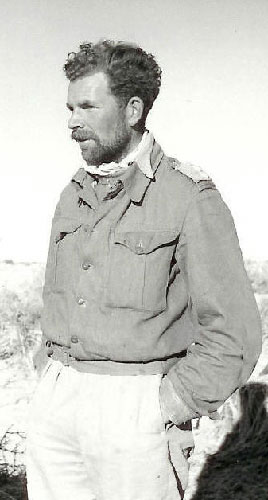
The Long Range Desert Group (LRDG) was a reconnaissance and raiding unit of the British Army during the Second World War.

The Chindits, officially known as Long Range Penetration Groups, were special operations units of the British and Indian armies which saw action in 1943–1944 during the Burma Campaign of World War II.

The United States Army Rangers are U.S. Army personnel who have served in any unit which has held the official designation of "Ranger". The term is commonly used to include graduates of the Ranger School, even if they have never served in a "Ranger" unit; the vast majority of Ranger school graduates never serve in Ranger units and are considered "Ranger qualified".

The 75th Ranger Regiment, also known as Army Rangers, is the premier light infantry unit and special operations force within the United States Army Special Operations Command. The regiment is headquartered at Fort Moore, Georgia and is composed of a regimental headquarters company, a military intelligence battalion, a special troops battalion, and three Ranger battalions.

Merrill’s Marauders (named after Frank Merrill) or Unit Galahad, officially named the 5307th Composite Unit (Provisional), was a United States Army long range penetration special operations jungle warfare unit, which fought in the Southeast Asian theater of World War II, or China-Burma-India Theater (CBI). The unit became famous for its deep-penetration missions behind Japanese lines, often engaging Japanese forces superior in number.

Major General Orde Charles Wingate, was a senior British Army officer known for his creation of the Chindit deep-penetration missions in Japanese-held territory during the Burma Campaign of the Second World War.

A long-range reconnaissance patrol, or LRRP, is a small, well-armed reconnaissance team that patrols deep in enemy-held territory.

Popski's Private Army, officially No. 1 Demolition Squadron, PPA, was a unit of British Special Forces set up in Cairo in October 1942 by Major Vladimir Peniakoff. Popski's Private Army was one of several raiding units formed in the Western Desert during the Second World War. The squadron also served in Italy, and was disbanded in September 1945.

Jungle warfare or woodland warfare is warfare in forests, jungles, or similar environments. The term encompasses military operations affected by the terrain, climate, vegetation, and wildlife of densely-wooded areas, as well as the strategies and tactics used by military forces in these situations and environments.

Brigadier James Michael Calvert, was a British Army officer who was involved in special operations in Burma during the Second World War. He participated in both Chindit operations and was instrumental in popularizing the unorthodox ideas of Orde Wingate. He frequently led attacks from the front, a practice that earned him the nickname amongst the men under his command of "Mad Mike."
The Order of battle of the Chindits, an Allied special force which carried out two deep penetration raids behind Japanese line during the Burma campaign in the South-East Asian Theatre of World War II

Special reconnaissance (SR) is conducted by small units, such as a recon team, made up of highly trained military personnel, usually from special forces units and/or military intelligence organizations. Special reconnaissance teams operate behind enemy lines, avoiding direct combat and detection by the enemy. As a role, SR is distinct from commando operations, but both are often carried out by the same units. The SR role frequently includes covert direction of airstrikes and indirect fire, in areas deep behind enemy lines, placement of remotely monitored sensors, and preparations for other special forces. Like other special forces, SR units may also carry out direct action and unconventional warfare, including guerrilla operations.

The Burma campaign in the South-East Asian Theatre of World War II took place over four years from 1942 to 1945. During the first year of the campaign, the Imperial Japanese Army with aid from Burmese insurgents had driven British forces and Chinese forces out of Burma, and occupied most of the country. From May to December 1942, most active campaigning ceased as the monsoon rains made tactical movement almost impossible in the forested and mountainous border between India and Burma, and both the Allies and Japanese faced severe logistical constraints.

Operation Caravan was a subsidiary of Operation Agreement under which four simultaneous raids were carried out against important Axis lines of communication positions in September 1942.

Special forces or special operations forces (SOF) are military units trained to conduct special operations. NATO has defined special operations as "military activities conducted by specially designated, organized, selected, trained and equipped forces using unconventional techniques and modes of employment".

John ("Jake") Richard Easonsmith was a British Army soldier during World War II. He was killed in action on the Dodecanese island of Leros whilst commanding the Long Range Desert Group in 1943. W. B. Kennedy-Shaw described him as: "Brave, wise, with an uprightness that shamed lesser men, he was, I think, the finest man we ever had in the L.R.D.G."
Brigadier Edward Cecil Osbaldeston Mitford Military Cross was a British officer in the British Army during the Second World War and after. He was an explorer of the Sahara desert before the war which was instrumental in his becoming one of the original members of the Long Range Desert Group. He later commanded five armoured regiments and an armoured brigade. He was also a member of the Mitford family from Northumberland.
Company E, 52nd Infantry, (LRP) was a 120 man-sized long-range reconnaissance patrol unit attached to the 1st Cavalry Division (Airmobile) in Vietnam in 1967-69. Its origin begins on January 1, 1967, as "LRRP Detachment G2," 1st Cavalry Division (Airmobile). It was then redesignated "Headquarters & Headquarters Company LRRP Detachment" in April 1967, and redesignated "Company E, 52nd Infantry (LRP)" on December 20, 1967.
Forward air control operations during World War II were begun as an ad hoc expedient to wartime conditions.
















